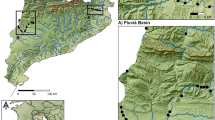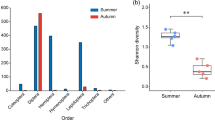Abstracts
The investigation of mechanism of species coexistence promotes understanding of the mechanistic processes behind community ecology and ecosystem functions. Niche theory declares that species coexistence within a community must partition the resources of their environment. Two sympatric and morphologically similar bat species, Rhinolophus affinis and Rhinolophus pearsoni, provided a unique opportunity to test the causal mechanism of coexistence. Previous study showed that their coexistence was promoted not by the trophic and spatial niche differentiation but the relatively high abundance of prey resources, which was not in accord with the prediction of niche theory. Here, therefore, we reanalyzed the dietary composition by fecal analysis and surveyed the feeding time of both species. Our results showed that R. affinis and R. pearsoni hunt mainly mostly on Coleoptera and Lepidoptera, and there was a very high overlap (0.84) of trophic niche between the two species. However, significant difference in the duration of the activity period between both species was detected, which illustrated that temporal partitioning of prey resource use facilitated their coexistence. Additionally, our work highlighted the importance of integration of the traditional methods and next-generation sequencing methods for identifying dietary composition of carnivores, and suggested that ongoing studies of species coexistence must consider simultaneously multiple niche axes.

Similar content being viewed by others
References
Adams RA, Thibault KM (2006) Temporal resource partitioning by bats at water holes. J Zool 270:466–472. doi:10.1111/j.1469-7998.2006.00152.x
Aguiar LMS, Antonini Y (2008) Diet of two sympatric insectivores bats (Chiroptera: Vespertilionidae) in the Cerrado of Central Brazil. Rev Bras Zool 25:28–31
Aguirre LF, Herrel A, Van Damme R, Matthysen E (2002) Ecomorphological analysis of trophic niche partitioning in a tropical savannah bat community. Proc R Soc Lond B 269:1271–1278. doi:10.1098/rspb.2002.2011
Arlettaz R, Perrin N, Hausser J (1997) Trophic resource partitioning and competition between the two sibling bat species Myotis myotis and Myotis blythii. J Anim Ecol 66:897–911. doi:10.2307/6005
Arlettaz R, Godat S, Meyer H (2000) Competition for food by expanding pipistrelle bat populations (Pipistrellus pipistrellus) might contribute to the decline of lesser horseshoe bats (Rhinolophus hipposideros). Biol Conserv 93:55–60. doi:10.1016/S0006-3207(99)00112-3
Ashrafi S, Beck A, Rutishauser M, Arlettaz R, Bontadina F (2011) Trophic niche partitioning of cryptic species of long-eared bats in Switzerland: implications for conservation. Eur J Wildlife Res 57:843–849. doi:10.1007/s10344-011-0496-z
Bumrungsri S, Leelapaibul W, Racey PA (2007) Resource partitioning in sympatric Cynopterus bats in lowland tropical rain forest, Thailand. Biotropica 39:241–248. doi:10.1111/j.1744-7429.2006.00245.x
Carbone C, Gittleman JL (2002) A common rule for the scaling of carnivore density. Science 295:2273–2276. doi:10.1126/science.1067994
Chamberlain MJ, Leopold BD (2005) Overlap in space use among bobcats (Lynx rufus), coyotes (Canis latrans) and gray foxes (Urocyon cinereoargenteus). Am Mid Nat 153:171–179. doi:10.1674/0003-0031(2005)153[0171:OISUAB]2.0.CO;2
Christopher CC, Barrett GW (2006) Coexistence of white-footed mice (Peromyscus leucopus) and golden mice (Ochrotomys nuttalli) in a southeastern forest. J Mammal 87:102–107. doi:10.1644/05-MAMM-A-013R1.1
Csorba G, Ujhelyi P, Thomas N (2003) Horseshoe bats of the world (Chiroptera: Rhinolophidae). Alana, Shropshire
Davidson-Watts I, Walls S, Jones G (2006) Differential habitat selection by Pipistrellus pipistrellus and Pipistrellus pygmaeus identifies distinct conservation needs for cryptic species of echolocating bats. Biol Conservat 133:118–127. doi:10.1016/j.biocon.2006.05.027
De Almeida Jácomo AT, Silveira L, Diniz-Filho JAF (2004) Niche separation between the maned wolf (Chrysocyon brachyurus), the crab-eating fox (Dusicyon thous) and the hoary fox (Dusicyon vetulus) in central Brazil. J Zool 262:99–106. doi:10.1017/S0952836903004473
Findley JS, Black H (1983) Morphological and dietary structuring of a Zambian insectivorous bat community. Ecology 64:625–630. doi:10.2307/1937180
Fukui D, Okazaki K, Maeda K (2009) Diet of three sympatric insectivorous bat species on Ishigaki Island, Japan. Endang Species Res 8:117–128. doi:10.3354/esr00156
González-Solís J, Oro D, Jover L, Ruiz X, Pedrocchi V (1997) Trophic niche width and overlap of two sympatric gulls in the southwestern Mediterranean. Oecologia 112:75–80. doi:10.1007/s004420050285
Hickey MBC, Acharya L, Pennington S (1996) Resource partitioning by two species of vespertilionid bats (Lasiurus cinereus and Lasiurus borealis) feeding around street lights. J Mammal 77:325–334. doi:10.2307/1382804
Jarman SN, Deagle BE, Gales NJ (2004) Group-specific polymerase chain reaction for DNA-based analysis of species diversity and identity in dietary samples. Mol Ecol 13:1313–1322. doi:10.1111/j.1365-294X.2004.02109.x
Jiang T, Jiang F, Sun K, Wang J (2008) Coexistence of two sympatric and morphologically similar bat species Rhinolophus affinis and Rhinolophus pearsoni. Prog Nat Sci 18:523–532. doi:10.1016/j.pnsc.2007.12.005
Johnson WE, Franklin WL (1994) Role of body size in the diets of sympatric gray and culpeo foxes. J Mammal 75:163–174. doi:10.2307/1382248
Kruuk H, Kanchanasaka B, O'Sullivan S, Wanghongsa S (1994) Niche separation in three sympatric otters Lutra perspicillata, L. lutra and Aonyx cinerea in Huai Kha Khaeng, Thailand. Biol Conserv 69:115–120. doi:10.1016/0006-3207(94)90334-4
Kunz TH, Fenton MB (2003) Bat ecology. University of Chicago Press, Chicago
Lanszki J, Heltai M (2010) Food preferences of golden jackals and sympatric red foxes in European temperate climate agricultural area (Hungary). Mammalia 74:267–273. doi:10.1515/MAMM.2010.005
Leibold MA, McPeek MA (2006) Coexistence of the niche and neutral perspectives in community ecology. Ecology 87:1399–1410. doi:10.1890/0012-9658(2006)87[1399:COTNAN]2.0.CO;2
Margalef DR (1958) Information theory in ecology. Gen Syst 3:36–71
McDonald JH (2009) Handbook of biological statistics. Sparky House, Baltimore
Mitchell-Jones AJ, McLeish AP (2004) The bat workers' manual. JNCC, Peterborough
Neuweiler G (1998) The biology of bats. Oxford University Press, Oxford
Norberg UM, Rayner JMV (1987) Ecological morphology and flight in bats (Mammalia: Chiroptera): wing adaptations, flight performance, foraging strategy and echolocation. Phil Trans R Soc B 316:335–427
O' Farrell MJ, Bradley WG (1970) Activity patterns of bats over a desert spring. J Mammal 51: 18–26. doi: http://www.jstor.org/stable/1378527
Pavey CR, Burwell CJ (1998) Predation on diurnal insects by the eastern horseshoe bat, Rhinolophus megaphyllus Gray (Chiroptera: Rhinolophidae). Mem Qld Mus 42:555–558
Pereira P, Alves da Silva A, Alves J, Matos M, Fonseca C (2012) Coexistence of carnivores in a heterogeneous landscape: habitat selection and ecological niches. Ecol Res. doi: 10.1007/s11284-012-0949-1
Pickett SB, Bergey CM, Di Fiore A (2012) A metagenomic study of primate insect diet diversity. Am J Primatol 74:622–631. doi: 10.1002/ajp.22014
Pompanon F, Deagle BE, Symondson WOC, Brown DS, Jarman SN, Taberlet P (2012) Who is eating what: diet assessment using next generation sequencing. Mol Ecol 21:1931–1950. doi:10.1111/j.1365-294X.2011.05403.x
Racey PA (1974) Ageing and assessment of reproductive status of Pipistrelle bats, Pipistrellus pipistrellus. J Zool 173:264–271. doi:10.1111/j.1469-7998.1974.tb03136.x
Razgour O, Korine C, Saltz D (2011) Does interspecific competition drive patterns of habitat use in desert bat communities? Oecologia 167:493–502. doi:10.1007/s00442-011-1995-z
Reside AE, Lumsden LF (2011) Resource partitioning by two closely-related sympatric freetail bats, Mormopterus spp. In: Law B (ed) Biology and conservation of Australasian bats. Royal Zoological Society of New South Wales, Mosman, N.S.W., pp 155–166
Schoener TW (1970) Nonsynchronous overlap of lizards in patchy habitats. 51:408–411. doi:10.2307/1935376
Sharifi M, Hemmati Z (2004) Variation in the diet of Mehely's Horseshoe Bat, Rhinolophus mehelyi, in three contrasting environments in western Iran. Zool Middle East 33:65–72
Shehzad W, Riaz T, Nawaz MA, Miquel C, Poillot C, Shah SA, Pompanon F, Coissac E, Taberlet P (2012) Carnivore diet analysis based on next-generation sequencing: application to the leopard cat (Prionailurus bengalensis) in Pakistan. Mol Ecol 21:1951–1965. doi:10.1111/j.1365-294X.2011.05424.x
Shiel C, McAney C, Sullivan C, Fairley J (1997) Identification of arthropod fragments in bat droppings. Mammal Society, London
Siemers BM, Swift SM (2006) Differences in sensory ecology contribute to resource partitioning in the bats Myotis bechsteinii and Myotis nattereri (Chiroptera: Vespertilionidae). Behav Ecol Sociobiol 59:373–380. doi:10.1007/s00265-005-0060-5
Siemers BM, Greif S, Borissov I, Voigt-Heucke SL, Voigt CC (2011) Divergent trophic levels in two cryptic sibling bat species. Oecologia 166:69–78. doi:10.1007/s00442-011-1940-1
Silva-Pereira JE, Moro-Rios RF, Bilski DR, Passos FC (2011) Diets of three sympatric Neotropical small cats: food niche overlap and interspecies differences in prey consumption. Mammal Biol 76:308–312. doi:10.1016/j.mambio.2010.09.001
Sun RY (2001) Principles of animal ecology. Beijing Normal University Press, Beijing (in Chinese)
Whitaker JOJ (1988) Food habits analysis of insectivorous bats. Smithsonian Institution, Washington, DC
Ye GX, Shi LM, Sun KP, Zhu X, Feng J (2009) Coexistence mechanism of two sympatric horseshoe bats (Rhinolophus sinicus and Rhinolophus affinis) (Rhinolophidae) with similar morphology and echolocation calls. Shengtai Xuebao/Acta Ecol Sinica 29:5330–5338
Acknowledgments
We would like to thank Guo Xinchun and Deng Guofang for their help in the field work. This project was supported by grants from the National Natural Science Foundation of China (Grant No. 31030011, 31100280), Research Fund for the Doctoral Program of Higher Education of China (20110043120015), and the Campus youth fund (10QNJJ015).
Author information
Authors and Affiliations
Corresponding author
Additional information
Communicated by: Karol Zub
Rights and permissions
About this article
Cite this article
Jiang, T., Lu, G., Sun, K. et al. Coexistence of Rhinolophus affinis and Rhinolophus pearsoni revisited. Acta Theriol 58, 47–53 (2013). https://doi.org/10.1007/s13364-012-0093-x
Received:
Accepted:
Published:
Issue Date:
DOI: https://doi.org/10.1007/s13364-012-0093-x




